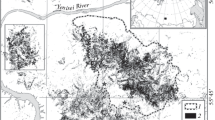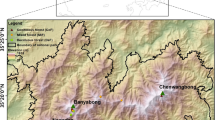Abstract
Increased dieback and mortality of “dark needle conifer” (DNC) stands (composed of fir (Abies sibirica), Siberian pine (Pinus sibirica) and spruce (Picea obovata)) were documented in Russia during recent decades. Here we analyzed spatial and temporal patterns of fir decline and mortality in the southern Siberian Mountains based on satellite, in situ and dendrochronological data. The studied stands are located within the boundary between DNC taiga to the north and forest-steppe to the south. Fir decline and mortality were observed to originate where topographic features contributed to maximal water-stress risk, i.e., steep (18°–25°), convex, south-facing slopes with a shallow well-drained root zone. Fir regeneration survived droughts and increased stem radial growth, while upper canopy trees died. Tree ring width (TRW) growth negatively correlated with vapor pressure deficit (VPD), drought index and occurrence of late frosts, and positively with soil water content. Previous year growth conditions (i.e., drought index, VPD, soil water anomalies) have a high impact on current TRW (r = 0.60–0.74). Fir mortality was induced by increased water stress and severe droughts (as a primary factor) in synergy with bark-beetles and fungi attacks (as secondary factors). Dendrochronology data indicated that fir mortality is a periodic process. In a future climate with increased aridity and drought frequency, fir (and Siberian pine) may disappear from portions of its current range (primarily within the boundary with the forest-steppe) and is likely to be replaced by drought-tolerant species such as Pinus sylvestris and Larix sibirica.





Similar content being viewed by others
References
Aitken SN, Yeaman S, Holliday JA, Wang T, Curtis-McLane S (2008) Adaptation, migration or extirpation: climate change outcomes for tree populations. Evol Appl 1(1):95–111. doi:10.1111/j.1752-4571.2007.00013.x
Allen CD, Breshears DD, McDowell NG (2015) On underestimation of global vulnerability to tree mortality and forest die-off from hotter drought in the Anthropocene. Ecosphere 6(8):129. doi:10.1890/ES15-00203.1
Anderegg LDL, Anderegg WRL, Berry JA (2013) Tree physiology review: not all droughts are created equal: translating meteorological drought into woody plant mortality. Tree Physiol 33(7):701–712. doi:10.1093/treephys/tpt044
Arhipova NG (2013) On the problem of spruce (Picea abies (L.) Karst.) decline in Latvia. In: The problem of spruce stands decline. Reports of International seminar. Colorpoint Publishing House, Minsk [In Russian]
Breda N, Huc R, Granier A, Dreyer E (2006) Temperate forest trees and stands under severe drought: a review of ecophysiological responses, adaptation processes and long-term consequences. Ann For Sci 63:625–644. doi:10.1051/forest:2006042
Choat B, Jansen S, Brodribb TJ, Cochard H, Delzon S, Bhaskar R, Bucci SJ, Field TS, Gleason SM, Hacke UG, Jacobsen AL, Lens F, Maherali H, Martínez-Vilalta J, Mayr S, Mencuccini M, Mitchell PJ, Nardini A, Pittermann J, Pratt RB, Sperry JS, Westoby M, Wright IJ, Zanne AE (2012) Global convergence in the vulnerability of forests to drought. Nature 491:752–755. doi:10.1038/nature11688
Chuprov NP (2008) About problem of spruce decay in European North of Russia. Rus J For 1:24–26 [In Russian]
Cook ER, Holmes RL (1986) Users manual for program Arstan. In: Holmes RL, Adams RK, Fritts HC (eds) Tree-ring chronologies of western North America: California, eastern Oregon and northern Great Basin. Laboratory of Tree-Ring Research, University of Arizona, Tucson, pp 50–65
Fettig CJ, Reid ML, Bentz BJ, Sevanto S, Spittlehouse DL, Wang T (2013) Changing climates, changing forests: a western North American perspective. J For 111(3):214–228. doi:10.5849/jof.12-085
Fritts HC (1991) Reconstruction large-scale climatic patterns from tree-ring data: a diagnostic analysis. University of Arizona Press, Tucson
Guarın A, Taylor AH (2005) Drought triggered tree mortality in mixed conifer forests in Yosemite National Park, California, USA. For Ecol Manag 218:229–244. doi:10.1016/j.foreco.2005.07.014
Hijioka Y, Lin E, Pereira JJ, Corlett RT, Cui X, Insarov GE, Lasco RD, Lindgren E, Surjan A (2014) Asia. In: Climate Change 2014: Impacts, Adaptation, and Vulnerability. Part B: Regional Aspects. Contribution of Working Group II to the Fifth Assessment Report of the Intergovernmental Panel on Climate Change [Barros, V.R., C.B. Field, D.J. Dokken, M.D. Mastrandrea, K.J. Mach, T.E. Bilir, M. Chatterjee, K.L. Ebi, Y.O. Estrada, R.C. Genova, B. Girma, E.S. Kissel, A.N. Levy, S. MacCracken, P.R. Mastrandrea, and L.L.White (eds.)]. Cambridge University Press, Cambridge, New York, NY, pp 1327–1370
Holmes RL (1983) Computer-assisted quality control in tree-ring dating and measurement. Tree-Ring Bull 44:69–75
Kagawa A, Sugimoto A, Maximov TC (2006) Seasonal course of translocation, storage and remobilization of 13C pulse-labeled photoassimilate in naturally growing Larix gmelinii saplings. N Phytol 171:793–804. doi:10.1111/j.1469-8137.2006.01780.x
Kharuk VI, Ranson KJ, Im ST, Dvinskaya ML (2006) Forest-tundra larch forests and climatic trends. Rus J Ecol 37(5):291–298. doi:10.1134/S1067413606050018
Kharuk VI, Im ST, Dvinskaya ML, Ranson KJ (2010) Climate-induced mountain treeline evolution in southern Siberia. Scand J For Res 25(5):446–454. doi:10.1080/02827581.2010.509329
Kharuk VI, Im ST, Oskorbin PA, Petrov IA, Ranson KJ (2013a) Siberian pine decline and mortality in southern Siberian mountains. For Ecol Manag 310:312–320. doi:10.1016/j.foreco.2013.08.042
Kharuk VI, Ranson KJ, Oskorbin PA, Im ST, Dvinskaya ML (2013b) Climate induced birch mortality in trans-Baikal lake region, Siberia. For Ecol Manag 289:385–392. doi:10.1016/j.foreco.2012.10.024
Kharuk VI, Im ST, Dvinskaya ML, Golukov AS, Ranson KJ (2015a) Climate-induced mortality of spruce stands in Belarus. Environ Res Lett. doi:10.1088/1748-9326/10/12/125006
Kharuk VI, Ranson KJ, Im ST, Petrov IA (2015b) Climate-induced larch growth response within central Siberian permafrost zone. Environ Res Lett. doi:10.1088/1748-9326/10/12/125009
Kirillov MV, Shherbakov YuA (eds) (1961) Krasnoyarsk region. Krasnoyarsk publishing house, Krasnoyarsk [In Russian]
Krylov GV (1961) Forests of West Siberia. AN SSSR, Moscow [In Russian]
Lausch A, Heurich M, Fahse L (2013) Spatio-temporal infestation patterns of Ips typographus (L.) in the Bavarian Forest National Park, Germany. Ecol Indic 31:73–81. doi:10.1016/j.ecolind.2012.07.026
Lloyd AH, Bunn AG (2007) Responses of the circumpolar boreal forest to 20th century climate variability. Environ Res Lett 2(4): 045013. doi: 10.1088/1748-9326/2/4/045013. http://iopscience.iop.org/1748-9326/2/4/045013. Accessed 22 Apr 2014
Long D, Longuevergne L, Scanlon BR (2014) Uncertainty in evapotranspiration from land surface modeling, remote sensing, and GRACE satellites. Water Resour Res 50(2):1131–1151
Man’ko YI, Gladkova GA, Butovets GN, Kamibayashi N (1998) An experience of monitoring fir-spruce forest decline in the central Sikhote–Alin. Rus J Forestry 1:3–16 [In Russian]
Martínez-Vilalta J, Lloret F, Breshears DD (2012) Drought-induced forest decline: causes, scope and implications. Biol Lett 8(5):689–691. doi:10.1098/rsbl.2011.1059
McDowell NG (2011) Mechanisms linking drought, hydraulics, carbon metabolism, and vegetation mortality. Plant Physiol 155:1051–1059. doi:10.1104/pp.110
Pavlov IN, Ruhullaeva OV, Barabanova OA, Ageev AA (2008) Estimation of root pathogens impact on forest resources of Siberian federal district. Boreal Zone Conifers 3(4):262–268 [In Russian]
Rautiainen M, Heiskanen J, Korhonen L (2012) Seasonal changes in canopy leaf area index and MODIS vegetation products for a boreal forest site in central Finland. Boreal Environ Res 17:72–84
Rinn F (1996) TSAP V 3.6 Reference manual: computer program for tree-ring analysis and presentation. Frank Rinn, Heidelberg
Russian Federal Agency of Forestry (2013) Annual report about state and exploitation of forests in Russian Federation in 2012. http://www.rosleshoz.gov.ru/docs/other/79. Accessed 28 July 2015 [in Russian]
Sazonov AA, Kuhta VN, Blinzov AI, Zvyaginzev VB, Ermohin MV (2013) The problem of large-scale spruce mortality in Belarus, and the ways of its solving. For Wildl 7:10–15 [In Russian]
Kharuk VI, Im ST, Petrov IA. “Dark needle conifer” decline in the Baikal Lake region. Contemp probl ecol (accepted)
StatSoft Inc. (2013) Electronic statistics textbook. http://www.statsoft.com/textbook. Accessed 29 May 2015
Stephenson NL (1990) Climatic control of vegetation distribution: the role of water balance. Am Nat 135:649–670. doi:10.1086/285067
Sterl A, Severijns C, Dijkstra H, Hazeleger W, van Oldenborgh GJ, van den Broeke M, Burgers G, van den Hurk B, van Leeuwen PJ, van Velthoven P (2008) When can we expect extremely high surface temperatures? Geophys Res Lett 35(14):L14703. doi: 10.1029/2008GL034071. http://onlinelibrary.wiley.com/doi/10.1029/2008GL034071/pdf. Accessed 22 Apr 2012
Stocker TF, Qin D, Plattner G-K, Tignor M, Allen SK, Boschung J, Nauels A, Xia Y, Bex V, Midgley PM (eds) (2013) Climate change 2013: the physical science basis. Contribution of working group I to the fifth assessment report of the intergovernmental panel on climate change. Cambridge University Press, Cambridge and New York. http://www.climatechange2013.org. http://www.ipcc.ch. Accessed 22 Apr 2014
Utkin AI (1975) Biological productivity of forests: study methods and results. For Silvic 1:9–189 [In Russian]
Vasilyauskas V (2013) Main causes of spruce decline in Lithuania. In: The problem of spruce stands decline. Reports of International seminar. Colorpoint Publishing House, Minsk. p 6–21. [In Russian]
Vicente-Serrano SM, Beguería S, López-Moreno I (2010) A multiscalar drought index sensitive to global warming. The standardized precipitation evapotranspiration index. J Clim 23:1696–1718. doi:10.1175/2009JCLI2909.1
Worrall JJ, Marchetti SB, Egeland L, Mask RA, Eager T, Howell B (2010) Effects and etiology of sudden aspen decline in southwestern Colorado USA. For Ecol Manag 260(5):638–648. doi:10.1016/j.foreco.2010.05.020
Yousefpour R, Hanewinkel M, Le Moguédec G (2010) Evaluating the suitability of management strategies of pure norway spruce forests in the black forest area of southwest Germany for adaptation to or mitigation of climate change. Environ Manag 45(2):387. doi:10.1007/s00267-009-9409-2
Zamolodchikov DG (2012) An estimate of climate related changes in tree species diversity based on the results of forest fund inventory. Biol Bull Rev 2(2):154–163. doi:10.1134/S2079086412020119
Acknowledgements
Authors thank anonymous reviewers for valuable comments. This research was supported by Russian Science Fund (RNF) Grant (No. 14-24-00112). K. J. Ranson’s contribution was supported in part by the NASA’s Terrestrial Ecology Program.
Funding
This study was supported by Russian Science Fund (RNF) (Grant No. 14-24-00112). K. J. Ranson’s contribution was supported in part by the NASA’s Terrestrial Ecology Program.
Author information
Authors and Affiliations
Corresponding author
Ethics declarations
Conflict of interest
The authors declare that they have no conflict of interest.
Additional information
Editor: Christopher Reyer.
Electronic supplementary material
Below is the link to the electronic supplementary material.
Rights and permissions
About this article
Cite this article
Kharuk, V.I., Im, S.T., Petrov, I.A. et al. Fir decline and mortality in the southern Siberian Mountains. Reg Environ Change 17, 803–812 (2017). https://doi.org/10.1007/s10113-016-1073-5
Received:
Accepted:
Published:
Issue Date:
DOI: https://doi.org/10.1007/s10113-016-1073-5




